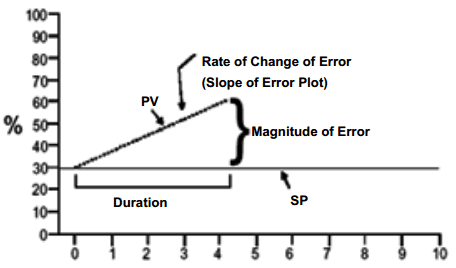As in any field, process control has its own set of common terms that you should be familiar with and that you will use when talking about control technology.
The Control Loop
Imagine you are sitting in a cabin in front of a small fire on a cold winter evening. You feel uncomfortably cold, so you throw another log on the fire. This is an example of a control loop. In the control loop, a variable (temperature) fell below the setpoint (your comfort level), and you took action to bring the process back into the desired condition by adding fuel to the fire. The control loop will now remain static until the temperature again rises above or falls below your comfort level.
Control loops in the process control industry work in the same way, requiring three tasks to occur:
❑ Measurement
❑ Comparison
❑ Adjustment
Many different instruments and devices may or may not be used in control loops (e.g., transmitters, sensors, controllers, valves, pumps), but the three tasks of measurement, comparison, and adjustment are always present.
Closed-loop Control Technology
Variables such as pressure, temperature or flow-rate often have to be set on large machines or systems. This setting should not change when faults occur. Such tasks are undertaken by a closed-loop controller. Control engineering deals with all problems that occur in this connection. The controlled variable is first measured and an electrical signal is created to allow an independent closed-loop controller to control the variable.
The measured value in the controller must then be compared with the desired value or the desired-value curve. The result of this comparison determines any action that needs to be taken. Finally a suitable location must be found in the system where the controlled variable can be influenced (for example the actuator of a heating system). This requires knowledge of how the system behaves.
Closed-loop control technology attempts to be generic – that is, to be applicable to various technologies. Most text books describe this with the aid of higher mathematics. The EMW articles describes the fundamentals of closed-loop control technology with minimum use of mathematics.
Reference Variable
In closed-loop control the task is to keep the controlled variable at the desired value or to follow the desired-value curve. This desired value is known as the reference variable.
Process Variable
A process variable is a condition of the process fluid (a liquid or gas) that can change the manufacturing process in some way. In the example of you sitting by the fire, the process variable was temperature. In the example of the filling tank, the process variable is level. Common process variables include:
❑ Pressure (Pressure in a pneumatic accumulator; Pressure of a hydraulic press;)
❑ Flow (Flow-rate of coolant in a heat exchanger)
❑ Level
❑ Temperature (Temperature in a galvanizing bath; Temperature of air, water..)
❑ Density
❑ Ph (acidity or alkalinity)
❑ Liquid interface (the relative amounts of different liquids that are combined in a vessel)
❑ Mass
❑ Conductivity
❑ Speed (Feed speed of a machine tool with electrical drive)
The variable that is subject to control is also called the controlled variable. So, the process variable and the controlled variable are two terms refering to one same thing.
Setpoint
The setpoint is a value for a process variable that is desired to be maintained. For example, if a process temperature needs to kept within 5 °C of 100 °C, then the setpoint is 100 °C. A temperature sensor can be used to help maintain the temperature at setpoint. The sensor is inserted into the process, and a contoller compares the temperature reading from the sensor to the setpoint. If the temperature reading is 110 °C, then the controller determines that the process is above setpoint and signals the fuel valve of the burner to close slightly until the process cools to 100 °C. Set points can also be maximum or minimum values. For example, level in tank cannot exceed 20 feet.
Manipulated Variable
The controlled variable in any system can be influenced. This influence allows the controlled variable to be changed to match the reference variable (desired value). The variable influenced in this way is called the manipulated variable. Examples of manipulated variable are:
❑ Position of the venting control valve of a air reservoir
❑ Position of a pneumatic pressure-control valve
❑ Voltage applied to the electrical heater of a galvanizing bath
❑ Position of the control valve in the coolant feed line
❑ Position of a valve in a chemical feed line
❑ Voltage on the armature of a DC motor
In the temperature control loop example, the measured variable is temperature, which must be held close to the desired value. In this example and in most instances, the measured variable is also the process variable. The measured variable is the condition of the process fluid that must be kept at the designated setpoint.
Sometimes the measured variable is not the same as the process variable. For example, a manufacturer may measure flow into and out of a storage tank to determine tank level. In this scenario, flow is the measured variable, and the process fluid level is the process variable. The factor that is changed to keep the measured variable at setpoint is called the manipulated variable. In the example described, the manipulated variable would also be flow.
Error
Error is the difference between the measured variable and the setpoint and can be either positive or negative. In the temperature control loop example, for instance, the error is the difference between the 110 °C measured variable and the 100 °C setpoint—that is, the error is +10 °C.
The objective of any control scheme is to minimize or eliminate error. Therefore, it is imperative that error be well understood. Any error can be seen as having three major components. These three components are shown on the Picture 1.
Picture 1: Components of Error

No comments:
Post a Comment